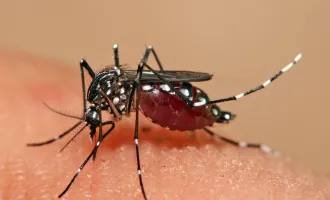NIH Official Warns of Challenging Times Ahead
Biomedical scientists face a multifaceted crisis of funding that threatens to slow the pace of discovery and discourage talented researchers from entering the biomedical workforce.
Despite this bleak outlook, “We cannot let science get ahead of us,” said Dr. Sally Rockey, the Deputy Director for Extramural Research of the National Institutes for Health (NIH), during a seminar for UCSF researchers on September 24.
During her presentation, which was part pep talk and part reality check, Rockey outlined both the mounting fiscal difficulties and attempted workarounds at the NIH in supporting biomedical research.
Impact of sequestration
Since last year, sequestration has resulted in the loss of 5 percent of NIH extramural funds, which has translated into a reduction in the number of awards made and also in the size of individual awards. These cuts (largely due to the sequester) come at a time when biomedical research is already reeling from a sharp drop in the success rates of grant awards.
In the period 1998-2003, the NIH budget doubled and award rates stood at around 30 percent. For 2012, after a significant slowdown in growth, current award estimates stand at around 18 percent of grant applications.
“While the budget has gone up by some, our buying power has gone down, because of the cost of research,” said Rockey.
In addition, large purchases for equipment or facilities expansions by laboratories and institutions during those relative times of wealth have made it more difficult to adjust to a slowdown in new awards. “If we had only grown by 3 percent a year, we would still be near where we are today, and it would have been easier to adjust”, she said. “We prefer steady growth. Flat becomes problematic.”
NIH: Doing more with less
Despite these difficulties, the NIH remains the steward of biomedical and behavioral research in the United States. So how can the NIH do more with less?
One way to encourage more scientists to continue applying for NIH grants — and more generally, to stay the course — is to provide extra review for those already awarded more than $1 million in NIH extramural funding, according to Rockey.
This “second look” encourages a more critical review of grant proposals written by well-funded PIs, with the eventual goal of maintaining a diverse group of funded laboratories. Additional programs include U01 grants intended to maximize collaboration with NIH hospitals.
Task force created
Those in charge at the NIH are also keenly aware that these difficulties may serve to discourage talented young scientists from remaining in academic research. The NIH recently launched the Biomedical Research Workforce working group, which included significant involvement from UCSF’s Keith Yamamoto, Vice Chancellor for Research in the School of Medicine.
Considering that 70 to 75 percent of the biomedical workforce is comprised of PhDs, the workforce working group focused its work on PhD researchers.
The data are overwhelming: Young scientists are being forced to deal with an increasingly protracted training period, due to the funding crisis. Currently, the average age of investigators who successfully receive their first R01 award, the common metric of success as an independent scientist and the primary yardstick for biomedical laboratory financing, is 42 years old.
The average age for all R01 awardees is now 53, indicating a significant skew of awards to older investigators. These numbers are discouraging for postdoctoral researchers in their 30s trying to plan the next stage of their careers — and their lives.
Retaining young scientists
It may come as a surprise to many trainees, but the NIH’s goal is to encourage these promising young scientists to stay in academic research, according to Rockey. The centerpiece of this goal is the BEST program: Broadening Experiences in Scientific Training, which provides grants for institutions (of which UCSF is one of 10) to better prepare biomedical students for careers in research.
Grants were reviewed in August, but it remains to be seen how this program will change graduate education at UCSF. Other initiatives include a push to reduce the length of graduate training by limiting NIH funds to five years, provide more “bridge” funding for the last year of postdoctoral training and increase the pay of postdoctoral researchers across the country, according to Rockey.
“We have been scientific leaders since World War II,” said Rockey. “We are a technology and technologically based economy — innovation based. That’s what drives us and drives us forward to being a strong economy. And yet, we are not investing in science.”
For more information on Dr. Sally Rockey’s perspective and ideas on improving research funding, visit her blog, “Rock Talk,” at http.//nexus.od.nih.gov/all/category/blog.


